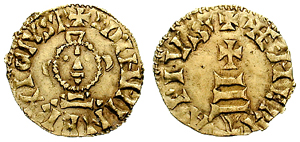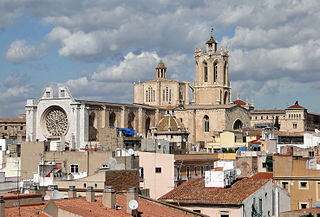
Toledo is a city and municipality of Spain, capital of the province of Toledo and the de jure seat of the government and parliament of the autonomous community of Castilla–La Mancha. Toledo was declared a World Heritage Site by UNESCO in 1986 for its extensive monumental and cultural heritage.
Pope Leo II was the bishop of Rome from 17 August 682 to his death. He is one of the popes of the Byzantine Papacy. Described by a contemporary biographer as both just and learned, he is commemorated as a saint in the Roman Martyrology on 28 June.
Priscillian was a wealthy nobleman of Roman Hispania who promoted a strict form of Christian asceticism. He became bishop of Ávila in 380. Certain practices of his followers were denounced at the Council of Zaragoza in 380. Tensions between Priscillian and bishops opposed to his views continued, as well as political maneuvering by both sides. Around 385, Priscillian was charged with sorcery and executed by authority of the Emperor Maximus. The ascetic movement Priscillianism is named after him, and continued in Hispania and Gaul until the late 6th century. Tractates by Priscillian and close followers, which were thought lost, were discovered in 1885 and published in 1889.
Priscillianism was a Christian sect developed in the Iberian Peninsula under the Roman Empire in the 4th century by Priscillian. It is derived from the Gnostic doctrines taught by Marcus, an Egyptian from Memphis. Priscillianism was later considered a heresy by both the Eastern Orthodox Church and the Roman Catholic Church.

The Third Council of Toledo (589) marks the entry of Visigothic Spain into the Catholic Church, and is known for codifying the filioque clause into Western Christianity. The council also enacted restrictions on Jews, and the conversion of the country to Catholic Christianity led to repeated conflict with the Jews.

The Synod of Elvira was an ecclesiastical synod held at Elvira in the Roman province of Hispania Baetica, now Granada in southern Spain. Its date has not been exactly determined but is believed to be in the first quarter of the fourth century, approximately 305–6. It was one of three councils, together with the Synod of Arles (314) and the Synod of Ancyra, that first approached the character of general councils and prepared the way for the first ecumenical council. It was attended by nineteen bishops and twenty-six presbyters, mostly resident in Baetica. Deacons and laymen were also present. Eighty-one canons are recorded, although it is believed that many were added at later dates. All concern order, discipline and conduct among the Christian community. Canon 36, forbidding the use of images in churches, became a bone of contention between Catholic and Protestant scholars after the Protestant Reformation.
Iria Flavia or simply Iria in Galicia, northwestern Spain, is an Ancient settlement and former bishopric in the modern municipality of Padrón, which remains a Catholic titular see.

Erwig was a king of the Visigoths in Hispania (680–687).

Julian of Toledo (642–690) was born in Toledo, Hispania. He was well educated at the cathedral school, was a monk and later abbot at Agali, a spiritual student of Saint Eugene II, and archbishop of Toledo. He was the first bishop to have primacy over the entire Iberian Peninsula—a position he has been accused of securing by being complicit in 680 in the supposed poisoning of Wamba, king of the Visigoths—and he helped centralize the Iberian Church in Toledo. His elevation to the position of primate of the Visigothic church was a source of great unhappiness among the kingdom's clergy. And his views regarding the doctrine of the Trinity proved distressing to the Vatican.
Beginning with three synods convened between 264 and 269 in the matter of Paul of Samosata, more than thirty councils were held in Antioch in ancient times. Most of these dealt with phases of the Arian and of the Christological controversies. For example, the Catholic Encyclopedia article on Paul of Samosata states:
It must be regarded as certain that the council which condemned Paul rejected the term homoousios; but naturally only in a false sense used by Paul; not, it seems because he meant by it a unity of Hypostasis in the Trinity, but because he intended by it a common substance out of which both Father and Son proceeded, or which it divided between them, — so St. Basil and St. Athanasius; but the question is not clear. The objectors to the Nicene doctrine in the fourth century made copious use of this disapproval of the Nicene word by a famous council.
The councils of Saragossa were a series of Christian councils held in Zaragoza, in what is now Spain.

Britonia is the historical, apparently Latinized name of a Celtic settlement by Romano-Britons on the Iberian peninsula following the Anglo-Saxon settlement of Britain. The area is roughly analogous to the northern parts of the modern provinces of A Coruña and Lugo in the autonomous community of Galicia, Spain.
The Twelfth Council of Toledo, held in Toledo, Spain, was initiated on 9 January 681 by the Visigothic King Erwig, who was elected king in 680. One of its first actions was to release the population from the laws of Wamba and recognise Erwig, anathematising all who opposed him.

The Diocese of Segorbe-Castellón is a Roman Catholic ecclesiastical territory located in north-eastern Spain, in the province of Castellón, part of the autonomous community of Valencia. The diocese forms part of the ecclesiastical province of Valencia, and is thus suffragan to the Archdiocese of Valencia.

The Archdiocese of Tarragona is a Roman Catholic ecclesiastical territory located in north-eastern Spain, in the province of Tarragona, part of the autonomous community of Catalonia. The archdiocese heads the ecclesiastical province of Tarragona, having Metropolitan authority over the suffragan dioceses of Girona, Lleida, Solsona, Tortosa, Urgell and Vic.

The Catholic Church in Spain has a long history, starting in the 1st century. It is the largest religion in Spain, with 58.6% of Spaniards identifying as Catholic.
De fisco Barcinonensi is a letter (epistola) from a group of bishops in the province of Tarraconensis in the Visigothic Kingdom to the treasury agents in Barcelona. The letter reminds the officials of the fixed rate of public tribute and demands that exactions in excess of that amount should stop. In the manuscripts, De fisco is preserved after the acts of the Second Council of Barcelona of 540, but its signatories are mostly those of the acts of the First Council of Zaragoza of 592. Most scholars believe it should be dated in connexion with the latter council. The bishops describe themselves as "all [those] who contribute to the fisc of the city of Barcelona", but the bishop of Barcelona, Ugnas, did not sign. The location of the regional fiscal administration in Barcelona perhaps explains why that city survived the Islamic conquest better than the provincial capital, Tarragona.
The Second Council of Seville was a synod of the ecclesiastical province of Baetica held in 619. It took place in the metropolis of Seville under the Archbishop Isidore. It was the first synod in Baetica since 592. It came shortly after a military campaign by the King Sisebut reincorporated a large part of Baetica into the Visigothic kingdom. This territory had previously been part of the Byzantine province of Spania. Its reincorporation would allow the bishop of Málaga to attend the synod.

Toledo is the repository of more than 2000 years of history. Successively a Roman municipium, the capital of the Visigothic Kingdom, a fortress of the Emirate of Cordoba, an outpost of the Christian Kingdom, and in the 16th century, the temporary seat of supreme power under Charles V. Its many works of art and architecture are the product of three major religions – Judaism, Christianity and Islam.
The Council of Toledo of 447 was the second Council of Toledo. It was a national council held against the Priscillianists, as called for by Pope Leo I. Nineteen bishops participated in the council, which condemned the heresy and the followers of Priscillian and affirmed the earlier First Council of Toledo, on which its Creed is based. It gave a profession of faith against all heretics with 18 anathemas attached against the doctrines of Priscillian. The council is notable for its successful subduing of Priscillianism, expressing a definition of dyophysitism before the Council of Chalcedon, its affirmation of the First Council of Toledo, and being the first known western council to include the "filioque" in its creed, following in the doctrine from Pope Leo I.









